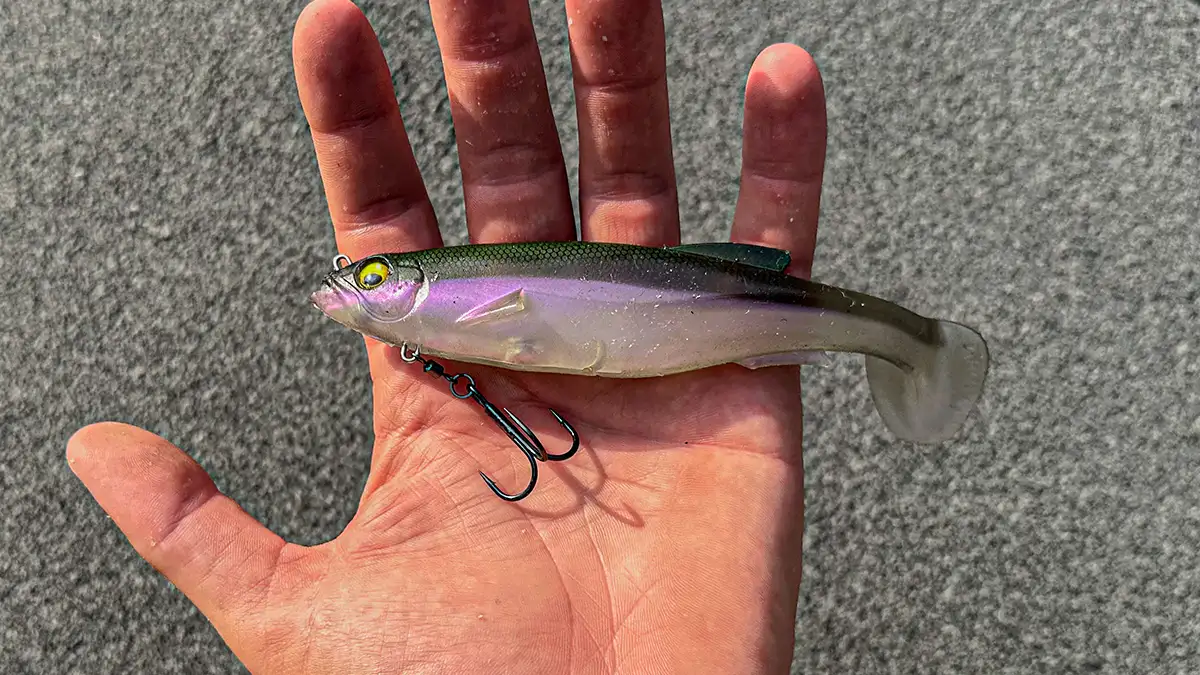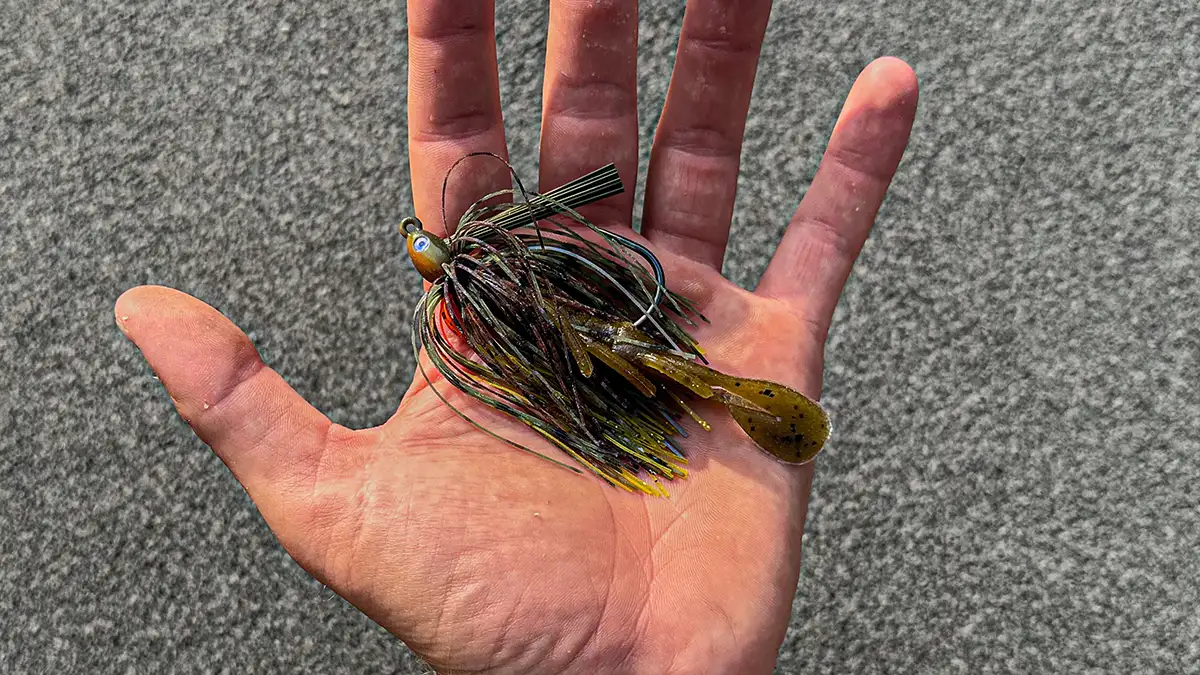A lot of baits in bass fishing seem similar in the places or ways you use them. That can sometimes make choosing the right lure a bit challenging. Take for instance, when an angler should use a swim jig versus a swimbait.
While both of these lures imitate the same type of forage, they are built to be used in different scenarios based on cover, water clarity and efficiency. Each lure was designed with specific attributes that make these baits better suited for specific types of cover. While it is a matter of preference, choosing the right bait can be the difference maker in coming home empty handed or having a successful day on the water.
BUILD COMPARISONS FOR SWIM JIGS AND SWIMBAITS
The biggest variation between these baits is how they are constructed. A swim jig consists of a lead head, heavy duty hook, a weed guard and a rubber skirt. This is an extremely versatile bait designed to be use in a variety of heavy cover situations. This bait can catch fish anywhere from 1 pound to 10 pounds, and is a great way to put a lot of fish in the boat. This lure is designed to be quickly maneuvered in and around heavy cover and is a great bait to cover water with in the fall months.
A swimbait is another great choice for bass, however its construction varies greatly from the typical swim jig. When I think of a shallow-water swimbait, I often think of a harness or line through style bait. These baits are constructed with a soft plastic body and either a harness or line through style treble hook. This construction allows the treble hook to lay almost flush with the bait, allowing it to come through the majority of sparse cover with ease. This bait’s realistic profile also makes it a great option for calling in fish from long distances. While a swimbait does catch small fish, it really shines when used around quality fish feeding on large forage.

COVER CAN DECIDE WHAT TO THROW
Cover is arguably the most important factor when choosing what bait to use. Efficiency is a critical component in covering water, and it is often the first thing I look at when choosing a bait. The amount of cover present can directly dictate how efficient you are at fishing a specific area, because of this, I like to choose a bait that is best suited to the type of cover present.
When fishing heavy cover such as thick laydowns or grass mats, I tend to opt for the swim jig. The straight shank hook and weed guard allows this bait to come over limbs and heavy grass without fear of fouling up. This allows you to be more aggressive with your casts and put your bait in places you otherwise wouldn’t be able to. This can often lead to more bites from fish that other anglers missed out on due to their bait selection.
This bait also gives you the ability to flip, pause and burn your lure in specific locations without hindering the baits action and performance. The pure versatility and efficiency of this bait make it a great option when fishing heavy cover scenarios.
While a swim jig is a great choice for heavy cover, I prefer a swimbait for sparse cover and open water scenarios. While the treble hook on these baits make it slightly cumbersome in heavy cover, it does great when fished around docks, overhangs and others types of sparse cover. A swim jig is great for getting your bait right in front of the fish due to its weedless nature, however the swimbait is great for calling fish out of heavy cover due to its realistic profile. This is a great option for fishing the edges of docks, laydowns or any other piece of cover that can be used as an ambush point.

SKIPPING WITH SWIM JIGS VS SWIMBAITS
Being able to effectively skip your lure in and around cover is another super important factor in being efficient on the water. While both of these lures can be skipped, they are each designed to be skipped around specific types of cover. I prefer to throw a swim jig when skipping my bait around tight locations with lots of snags such as thick laydowns or cumbersome docks. The weed guard on this bait allows you to rocket the lure to the back of cover without fear of snagging on the surrounding cover. This is super important when you are making tons of skips throughout the course of the day.
While skipping a swim jig is more practical around heavy cover, I like to skip a swimbait around docks, overhangs and other types of sparse cover. The soft plastic body of these swimbaits allow this lure to skip with ease, making it super efficient around docks or other types of shade lines. This is the perfect bait for skipping under floating docks, marina slips or any other type of cover that provides shade for bass.

WATER CLARITY MATTERS IN CHOOSING A SWIM JIG OR SWIMBAIT
Water clarity is another super important factor when deciding what bait to use. The clarity of the water dictates how well the bass can see your lure, ultimately affecting if the bass will commit to your bait. When fishing around clear or lightly stained water, I tend to opt for the swimbait.
The natural profile of this bait is great for tricking weary bass in clear water, and is a consistent way to put quality bass in the boat when facing these conditions. Drawing power is another important factor when fishing around clear water. A swimbait is great for getting fish to come out of cover and chase down your lure from a longer distance. This is important when covering water because it allows you to cover more area with each cast. The swimbait is my go to bait In the majority of clear water power fishing scenarios.
While a swimbait excels in clear water, the swim jig is great for dirty or stained water scenarios. A swimbait is often fished using a slow and steady retrieve with little variation. This displaces minimum water making it a subpar option when fishing in low visibility scenarios. The swim jig however is often fished by employing a mix of jerks, pauses and irregular actions causing this bait to displace a ton of water. This is important in dirty water scenarios as it allows fish to easily key on your bait when visibility is low. The swim jig is my go to bait in the majority of dirty water power fishing scenarios.
Both a swim jig and swimbait are great options for covering water in bass fishing. They each have their own unique advantages and disadvantages based on cover, water clarity, and overall efficiency. While there is no true right or wrong answer, this feature will give you the proper understanding to make an informed decision when deciding whether to throw a swim jig or swimbait based on the current conditions.












